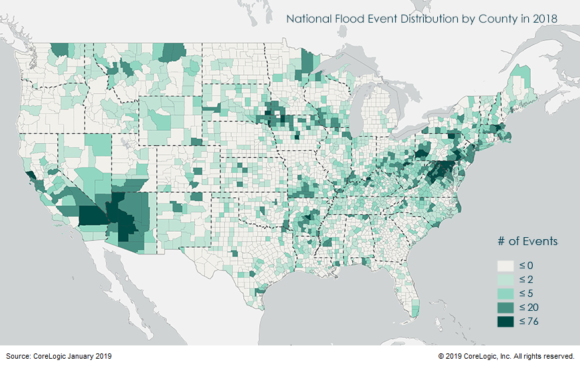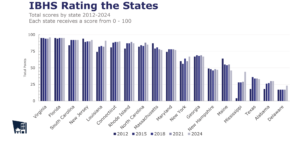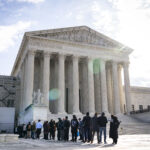When it comes to natural disasters, 2018 was an eventful year worldwide. Typhoons devastated the Philippines, Hong Kong, Japan and Oman. Earthquakes caused mass casualties in Indonesia, business interruption in Japan and structure damage in Alaska. Volcanoes made the news in Hawaii, expanding the island’s terrain. Wildfires scorched the West Coast of the United States; Hurricanes Michael and Florence battered the Gulf and East Coasts.
1,000-year flood events (or floods that are said statistically to have a 1 in 1,000 chance of occurring) reoccurred after one-to-two years in Maryland, North Carolina, South Carolina, Texas and Wisconsin. Severe convective storms pelted Dallas, Texas and Colorado Springs, Colorado with large hail while a rash of tornado outbreaks, spawning 82 tornadoes in total, occurred from Western Louisiana and Arkansas all the way down to Southern Florida and up to Western Virginia.
According to the National Oceanic and Atmospheric Administration (NOAA)[1], there were 11 weather and climate disaster events with losses exceeding $1 billion in the U.S. alone. Although last year’s count of billion-dollar events is a decrease from the previous year, both 2017 and 2018 have tracked far above the 1980-2017 annual average of $6 billion in total dollar amount in one year.
Annually, CoreLogic takes stock of the events that passed to help protect homeowners and businesses from the financial devastation that often follows catastrophe.
Highlights from the analysis this year include:

- Over 1,600 significant flood events occurred in the U.S., 59 percent of which were flash flood-related.
- Residential and commercial flood damage in North Carolina, South Carolina and Virginia from Hurricane Florence is estimated at $19 billion to $28.5 billion, of which roughly 85 percent was uninsured.
- The 2018 Atlantic Hurricane season saw 15 named storms, eight of which were named hurricanes. Two of these, Hurricanes Florence (Category 1) and Michael (Category 4), made landfall along the U.S. This made 2018 the third back-to-back season of above-average hurricane activity in the Atlantic.
- The number of acres that burned in 2018 is the eighth highest in U.S. history as reported through November 30, 2018.
- A total of 11 western states had at least one wildfire that exceeded 50,000 burned acres; the leading states were California and Oregon, each with seven fires that burned more than 50,000 acres.
No one can stop a hurricane in its tracks or steady the ground from an earthquake, but with more information and an understanding of the risk, property owners and insurers can accelerate recovery and attain resiliency. This assessment covers an analysis of what the risk and exposure looked like, what happened during the event and the residential and commercial losses which occurred in the aftermath for each notable climatological event.
You can read the full analysis here. For more information and to keep up to date with the events as they happen, visit our natural hazard risk information site Hazard HQ™.




















 That Insurance Talent Crisis? It’s a Global Knowledge Opportunity
That Insurance Talent Crisis? It’s a Global Knowledge Opportunity  Worst Is Over: Most of Casualty Reserve Hole May Be Filled, Analyst Says
Worst Is Over: Most of Casualty Reserve Hole May Be Filled, Analyst Says  Study: Average Cyber Breach Insurance Coverage Gap is 350%
Study: Average Cyber Breach Insurance Coverage Gap is 350%  The Supreme Court Just Complicated Employer Diversity Initiatives
The Supreme Court Just Complicated Employer Diversity Initiatives 



